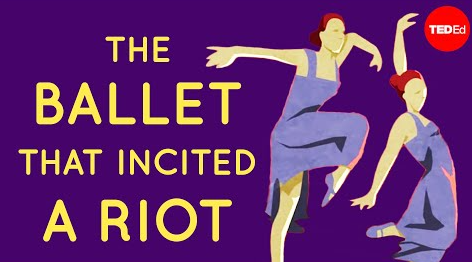We typically think of ballet as harmonious, graceful and polished -- hardly features that would trigger a riot.
我们一般会认为芭蕾是和谐、优美和典雅的--不太可能和引发暴乱产生联系。
But at the first performance of Igor Stravinsky's "The Rite of Spring," audience members were so outraged that they drowned out the orchestra.
但在伊戈尔·斯特拉文斯基《春之祭》的首场演出中,观众极其愤怒,吵闹声甚至压过了管弦乐团。
Accounts of the event include people hurling objects at the stage, challenging each other to fights, and getting arrested
对该事件的记述包括:观众往台上扔东西,互相挑起争执并打作一团,随后多人被逮捕,
all on what started as a sophisticated night at the ballet.
一切都开始于理应雅致的芭蕾舞之夜。
First performed in May 1913 at the Théatre des Champs-Elysées in Paris, "The Rite of Spring" is set in prehistoric times.
1913年5月,《春之祭》在巴黎香榭丽舍剧院进行了首场演出,整部剧背景设定是在史前时期。
The narrative follows an ancient Pagan community worshipping the Earth and preparing for the sacrifice of a woman intended to bring about the change of seasons.
故事讲述的是一个古老的异教徒团体正在膜拜地球,并且准备献祭一位女性,希望能改变季节的变化。
But the ballet is much more concerned with the violent relationship between humans, nature, and culture than with character or plot.
但是这场芭蕾着重表现的是人类、自然与文化之间的暴力联系,而不是角色或是情节。
These themes manifest in a truly upsetting production which combines harsh music, jerky dancing, and uncanny staging.
这些主题充斥着令人烦乱的场景,像是刺耳的音乐、急促的舞步和怪诞的舞台。
It opens with dancers awakening to a solo bassoon, playing in an eerily high register.
开幕时,舞者在怪诞的高音域大管独奏中醒来。
This gives way to discordant strings, punctured by unexpected pauses while the dancers twitch to the music.
紧随其后的是极不协调的管弦乐,穿插着各种出其不意的停顿,同时,舞者随着音乐颤动身体。
These frightening figures enact the ballet's brutal premise, which set audiences on edge and shattered the conventions of classical music.
这些令人毛骨悚然的身影揭示了芭蕾舞暴力的预设,让观众紧张不安,并打破了古典音乐的传统韵律。
In these ways and many more, "The Rite of Spring" challenged the orchestral traditions of the 19th century.
除此之外,《春之祭》还通过多种方式挑战了19世纪的管弦乐传统。
Composed on the cusp of both the first World War and the Russian revolution, "The Rite of Spring" seethes with urgency.
创作于第一次世界大战与俄罗斯革命的关口,《春之祭》点燃了一种急迫感。
This tension is reflected in various formal experiments, including innovative uses of syncopation, or irregular rhythm;
这种紧张感反映在了多种演奏尝试中,包括出其不意的停顿,或是不规则的节奏;
atonality or the lack of a single key, and the presence of multiple time signatures.
无调性或是单音缺失,以及使用多种节拍记号。
Alongside these strikingly modern features, Stravinsky spliced in aspects of Russian folk music
除了这些非常现代的特征之外,斯特拉文斯基还结合了俄罗斯民间音乐,
a combination that deliberately disrupted the expectations of his sophisticated, urban audience.
这种结合有意打消了经验丰富的城市观众对他的期待。
This wasn't Stravinsky's first use of folk music.
这并不是斯特拉文斯基首次使用民间音乐。

Born in a small town outside of St. Petersburg in 1882, Stravinsky's reputation was cemented with the lush ballet "The Firebird."
1882年出生在圣彼得堡外一个小镇的斯特拉文斯基,用华丽的芭蕾舞巨作《火鸟》奠定了他的名声。
Based on a Russian fairytale, this production was steeped in Stravinsky's fascination with folk culture.
这部作品取材于一个俄罗斯童话,内容充分体现了斯特拉文斯基对民俗文化的着迷。
But he plotted a wilder project in "The Rite of Spring," pushing folk and musical boundaries to draw out the rawness of pagan ritual.
但他在《春之祭》中策划了更狂野的设想,挑战了民俗和音乐的界限,以呈现异教形式的原始性。
Stravinsky brought this reverie to life in collaboration with artist Nicholas Roerich.
通过和艺术家尼古拉斯·洛里奇合作,斯特拉文斯基得以让幻想成真。
Roerich was obsessed with prehistoric times. He had published essays about human sacrifice and worked on excavations of Slavic tombs in addition to set and costume design.
洛里奇很迷恋文字记载出现之前的时代,他发表过一些关于活人祭的文章,并参与了斯拉夫墓的发掘工作,此外,他还从事布景和时装设计。
For "The Rite of Spring," he drew from Russian medieval art and peasant garments to create costumes that hung awkwardly on the dancers' bodies.
在《春之祭》中,他参考俄国中世纪艺术和农民的服饰,设计出了舞者身上简陋的服饰。
Roerich set them against vivid backdrops of primeval nature; full of jagged rocks, looming trees and nightmarish colors.
洛里奇还将它们搭配上了原始生动的布景,满是岩石,若隐若现的树木和噩梦般的色彩。
Along with its dazzling sets and searing score, the original choreography for "The Rite of Spring" was highly provocative.
炫目的布景以及刺耳的配乐让《春之祭》的原版编舞时刻挑战着观众的神经。
This was the doing of legendary dancer Vaslav Nijinsky, who developed dances to rethink "the roots of movement itself."
这是传奇舞者瓦斯拉夫·尼金斯基的杰作,他创作了让人反思“动作之根本”的舞蹈。
Although Stravinsky later expressed frustration with Nijinsky's demanding rehearsals and single-minded interpretations of the music,
虽然斯特拉文斯基随后因尼金斯基对排练要求苛刻,且只对音乐做单一的诠释而心生不满,
his choreography proved as pioneering as Stravinsky's composition.
但就如同斯特拉文斯基的作曲,尼金斯基的编舞也极具开创性。
He contorted traditional ballet -- to both the awe and horror of his audience, many of whom expected the refinement and romance of the genre.
他打破了传统的芭蕾--许多期待在作品中体验优雅和浪漫的观众感觉到的却是敬畏和恐惧。
The dancing in "The Rite of Spring" is agitated and uneven, with performers cowering, writhing and leaping about as if possessed.
《春之祭》的舞蹈很激烈、无序,表演者像是中了邪一样,不停蜷缩、扭曲、来回跳跃。
Often, the dancers are not one with the music but rather seem to struggle against it.
通常,舞者们没有与音乐合二为一,反而像是挣扎着摆脱音乐。
Nijinsky instructed them to turn their toes inwards and land heavily after jumps, often off the beat.
尼金斯基要求他们把脚趾转向内测,跳跃之后要重重落地,而非踩在节拍上。
For the final, frenzied scene, a woman dances herself to death to loud bangs and jarring strings. The ballet ends abruptly on a harsh, haunting chord.
在疯狂的最后一幕,一名女子在震耳欲聋的管弦乐中独舞至死。这部芭蕾舞剧在刺耳、恼人的和弦中唐突结束。
Today, "The Rite of Spring" remains as chilling as its controversial debut, but the shockwaves of the original work continue to resound and inspire.
今天,《春之祭》仍然和当年的首演一样让人汗毛倒竖,但原作震撼人心的余波仍然在久久回荡,启迪人心。
You can hear Stravinsky's influence in modern jazz's dueling rhythms, folky classical music,
受到斯特拉文斯基影响的现代爵士乐中的决斗节奏、很多民间古典音乐,
and even film scores for horror movies, which still illicit a riotous audience response.
甚至是恐怖电影的配乐,仍然会在观众席中引发一阵骚动。


